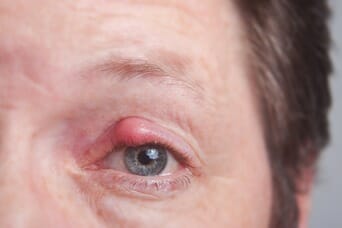My Personal Story
I had recurring chalazia several times a year. I was at my wits end until I found TheraLife. Here is my story.
No more recurring Chalazia- Relief From TheraLife
I was having painful chalazia just about every month. My eye doctor recommended cleaning my eye lids with baby shampoo, my lids are red and swollen, my vision became blurry, light sensitive. I found TheraLIfe on the internet and ordered the Chalazion Starter Kit. Withjn one week, my eye lids are no longer red and swollen, and I have not had any chalazion for the last 3 months. Dr. Yang works with me to make sure I am getting results. So happy to have found TheraLife.
- Binder – Canada
Stop Chalazia Recurrence Now
TheraLife Eye capsules – fast relieve for chronic dry eye and clogged oil glands. Root cause of chalazion.
Get help today!
What is chalazia?
A chalazion is a blockage in a small duct in your eyelid (called the meibomian glands) that can result in a small bump and cause eyelid swelling. Each of your eyelids has small glands called meibomian glands located near the eyelashes, which produce one of the oils that lubricates your eye. When these glands cannot release their oil because their duct is blocked, the oil backs up and causes a bump. A chalazion is not the result of an infection, although it can follow an infection of the eye. An infection of these same small ducts is called a stye, which may resemble a chalazion but is usually quite painful and tender, while a chalazion is less painful. A chalazion can grow to the size of a marble in extreme circumstances. Some people have recurring chalazion or styes. This is a chronic condition that requires treatment. TheraLife has the perfect solution.
Pliurel of chalazion is chalazia
Chalazia Causes
Each of the oil glands, called meibomian glands, produces oil that flows out of the gland into the tears to make the tears thicker. There are about 30 to 40 of these glands within each of the upper and lower lids. The oil comes out from each gland through a tiny circular opening just behind the eyelashes of the upper and lower lids of both eyes. Chalazia is caused by the oil in the gland becoming too thick to flow out of the gland or the opening of the gland being obstructed. Without anywhere to go, the oil builds up inside the gland and forms a lump or type of cyst in the eyelid. The gland wall may break, releasing the oil into the tissue of the eyelid, causing inflammation and sometimes scar tissue. Alternative names for a chalazia include conjunctival granuloma, conjunctival lipogranuloma, or meibomian gland lipogranuloma.
Chalazia vs Stye
Although a stye is also a lump in the eyelid caused by obstruction of an oil gland, a chalazion is not a stye. A stye, represents an acute infection of the gland. Chalazia is not infectious but is an inflammation of the area. Inflammation is a process in which the body reacts to a condition and produces swelling, redness, pain, or warmth. A stye is usually more painful than chalazia and may appear infected.
Chalazia Risk Factors
Risk factors for chalazia include a prior history of chalazia, acne rosacea, a family history of chalazia, and oily skin.
Chalazia Symptoms and Signs
- Swelling of the upper or lower eyelid may occur gradually over weeks with chalazia (the plural form of chalazion) occurring more frequently on the upper lid.
- A chalazion appears as a localized hard lump that may grow as large as 1/8 of an inch.
- Occasionally, one may feel pain and the eyelid may be red. A chalazion of the lower eyelid may be more visible when one looks inside the lid while looking in a mirror.
Contact an ophthalmologist immediately for frequent bouts of eyelid swelling or if experiencing any of the following:
- Fever
- Headache
- Any visual changes (for example, blurred vision, decreased ability to see)
- Eye pain and/or drainage
- Extensive swelling or redness
Chalazia Diagnosis
Your eye doctor will take a medical history and perform a physical examination. The examination includes vision testing of each eye and an inspection of the face, eyelids, and the eye itself. In addition to examining the skin of the eyelids, an ophthalmologist may look inside the upper eyelid if the lump is in the upper lid.
- Hot Compress for 5 to 10 minutes, 4 times a day to reduce swelling and promote drainage of the gland is highly recommended. We recommend a rice baggy or a gel type of hot compress that heats up in the microwave oven
- Anti-biotics – A prescription for antibiotic eye drops or ointments if a bacterial infection is suspected.
- Steroid Injection – in the area of the lump to help decrease the inflammation
- Surgery – If a chalazion creates lasts for weeks, it may need to be surgically removed. If the swelling has lasted more than a few weeks or creates symptoms of blurry vision, your eye doctor may recommend surgery to remove the chalazion. If the appearance of the chalazion is bothersome, surgical removal may also be indicated.
Recurring Chronic Chalazia
For people with acne rosacea, oily skin or history of chalazia.
Diagnosis of recurring chalazia
A wide spectrum of disease. OSSN is an umbrella term for a spectrum of dysplastic and malignant epithelial lesions of the conjunctiva and cornea. OSSN lesions involving only the epithelium may be termed conjunctival squamous neoplasia.1 Risk factors include ultraviolet light exposure, human papilloma virus (type 16) infection, HIV/AIDS, and xeroderma pigmentosum.
Histology determines the OSSN spectrum:
- Grade 1, conjunctival epithelial dysplasia: Dysplastic cells are confined to the basal layers of the epithelium.
- Grade 2, carcinoma-in-situ: The lesion involves the full thickness of the epithelium.
- Grade 3, squamous cell carcinoma: Invasive disease is present.
Presentation. The most common presentation of OSSN is an elevated, vascularized lesion in the limbal region of older patients. Ms. Cooke’s orbital mass was an unusual presentation.
Treatment. OSSN is typically treated with wide surgical excision and, to reduce recurrence, adjunctive techniques (e.g., application of alcohol or cryotherapy). One should refrain from direct manipulation of the tumor to avert microscopic seeding to other ocular structures (“no touch” technique).
Recently, there has been a paradigm shift in the treatment approach to OSSN. Clinicians may now use topical chemotherapy as both adjunctive and primary therapy. Topical mitomycin C, 5-fluorouracil, and interferon alfa have been shown to be effective. Galor et al. advocated adjuvant interferon therapy in patients with high-risk characteristics after surgery—namely, positive margins, tarsal involvement, or recurrent disease. Radiation therapy or enucleation remains reserved for those with intraocular or orbital invasion and systemic metastasis, which fortunately are uncommon in OSSN.
Recurrence. Positive surgical margins have long been identified as a risk factor for recurrence, with some series showing that excised lesions with negative surgical margins had a recurrence rate of 5%, compared with 53% for those with positive margins.
Recurring chalazia Treatment
For recurring chronic chalazia, a generalized abnormality in the oil glands should be considered. This can be treated with long-term oral tetracycline or doxycycline to change the consistency of the oils produced by the glands. The use of hot compresses prior to sleep and cleaning the eye lid margins using an eye lid cleanser should be a routine procedure. Inevitably, dry eye syndrome is involved with people with chalazia.
Why TheraLife?
Dry eye relief in addition chalazia treatment makes sense. For the most effective recurring chalazia relief, try TheraLife Chalazion Starter Kit. This kit consists of 4 bottles of Theralife Eye, 1 bottle of Fish Oil, 1 gel hot compress and 1 Hypochlor eye lid cleanser. Keep your eye lids clean, healthy and restore your normal tear function all in one kit. Read more customer testimonials here. Call and talk to a Dr. Yang toll free 1-877-917-1989 US/Canada. International (650) 949-6080 Email inquiries to: [email protected]
Frequently Asked Questions
Can a chalazion cause dry eyes?
Chalazion can cause eye discomfort. Most likely however, dry eyes cause chalazion by having clogged meibomian oil glands.
Can chalazion cause eye problems?
Chalazion can cause eye problem by rubbing against cornea resulting in blurry vision, and distorted vision.
Does eyelid inflammation cause dry eyes?
Conclusion
Chalazion causes meibomian gland loss, and the range of meibomian gland loss is not related to the treatment method but to the range of chalazion itself. A hot compress as part of conservative treatment can improve meibomian gland function at the site of chalazion in the short term.
References
1 Chalazion. www.guysandstthomas.nhs.uk/our-services/eye/patients/eye-patient-leaflets.aspx. Accessed July 10, 2015.
2 Goawalla A, Lee V. Clin Experiment Ophthalmol. 2007;35(8):706-712.
3 Ben Simon GJ et al. Am J Ophthalmol. 2011;151(4):714-718.
4 Ben Simon GJ et al. Ophthalmology. 2005;112(5):913-917.
5 Hayashi N et al. Virchows Arch. 1994;424(5):503-509.
6 Abboud IA et al. Exper Eye Res. 1968;7(3):383-387.
7 Chen L et al. Am J Ophthalmol. 2014;157(5):1103-1108.






What an insightful article about chalazion. Thank you